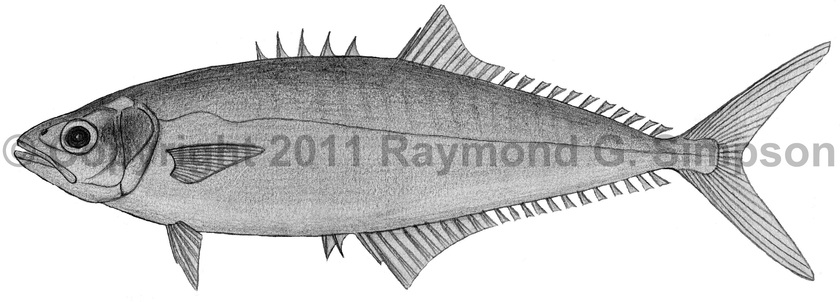
Common Name
Atlantic Leatherjacket
Year Described
Bloch & Schneider, 1801
Identification
Dorsal Fin: 5 spines (rarely 4 or 6) in first lobe, followed by I, 19-21 (posterior 11-15 rays are individual finlets)
Anal Fin: 2 spines separate from rest, followed by I, 19-22 (posterior 11-15 rays are individual finlets)
Pelvic Fin: I, 5
Gill Rakers: 5-8 upper, 13-16 lower; 19-23 total
Vertebrae: 10 precaudal, 16 caudal
Elongate, ovoid, and compressed, with a small head and small eye (4.0-4.5 times in HL). Forehead slightly concave in profile, lower head more convex. Jaw non-protractile at snout tip, reaches to posterior margin of eye. Teeth small, in two rows in both jaws. Pectoral fins shorter than head. Second dorsal and anal fins with raised anterior lobes. Tail deeply forked. Lateral line with small curve above pectoral fin and straight along rest of length without scutes. Scales needle-like and embedded in skin. Caudal keels and grooves absent.
Color
Blue, blue-green, to gray above, grading to silvery and white below. Sometimes with short white bands on body along lateral line and/or a yellow wash on the posterior part of the body. Dorsal spines black, membranes clear. Second dorsal and anal fins clear to yellowish, with dusky lobes. Caudal fin dusky to yellow.
Size
Common to 27cm. Maximum size to 30cm.
Habitat
Shallow water, from the surf zone to estuaries. Can tolerate very low salinities. Forms large schools.
Range
Massachusetts to Brazil, including the Caribbean islands.
References
Smith-Vaniz, W.F. 2003. Carangidae (pp 1426-1468). In: Carpenter. 2003. The living marine resources of the Western Central Atlantic v. 3.